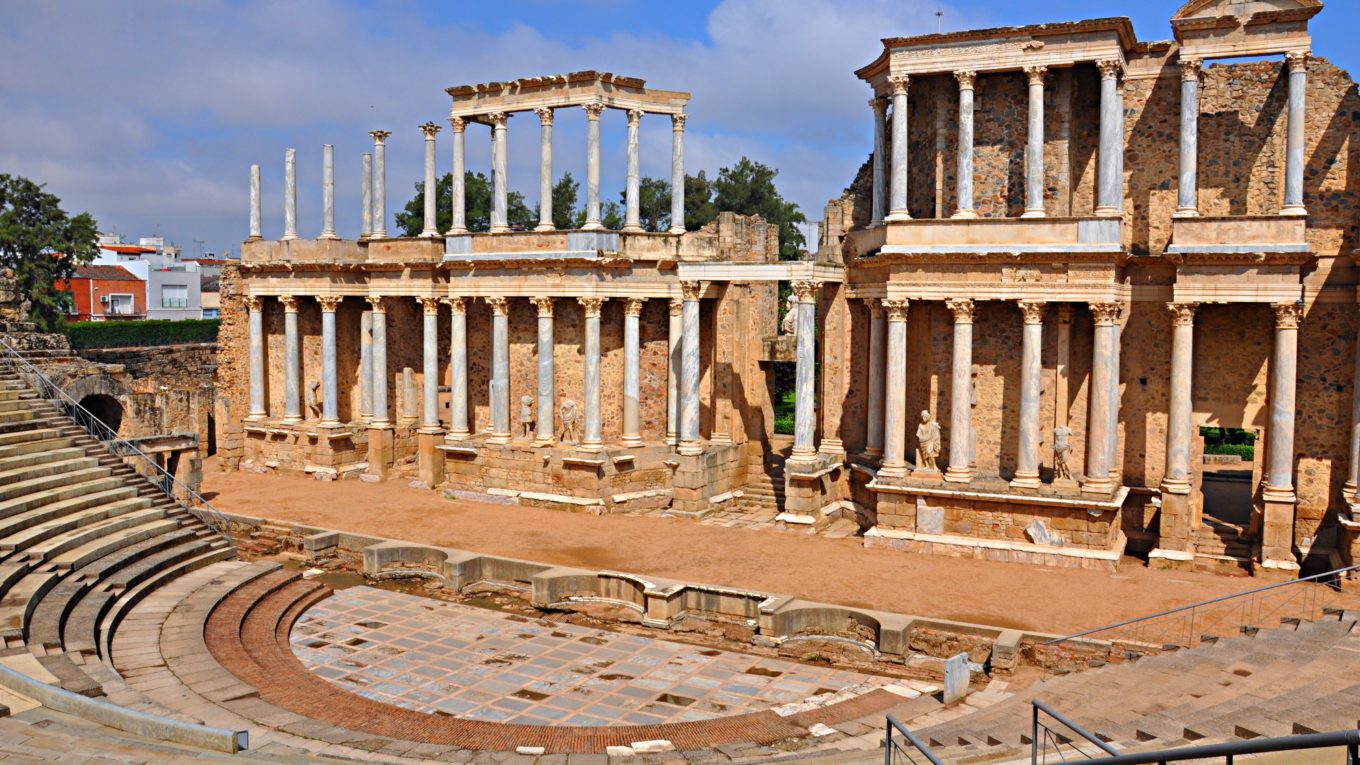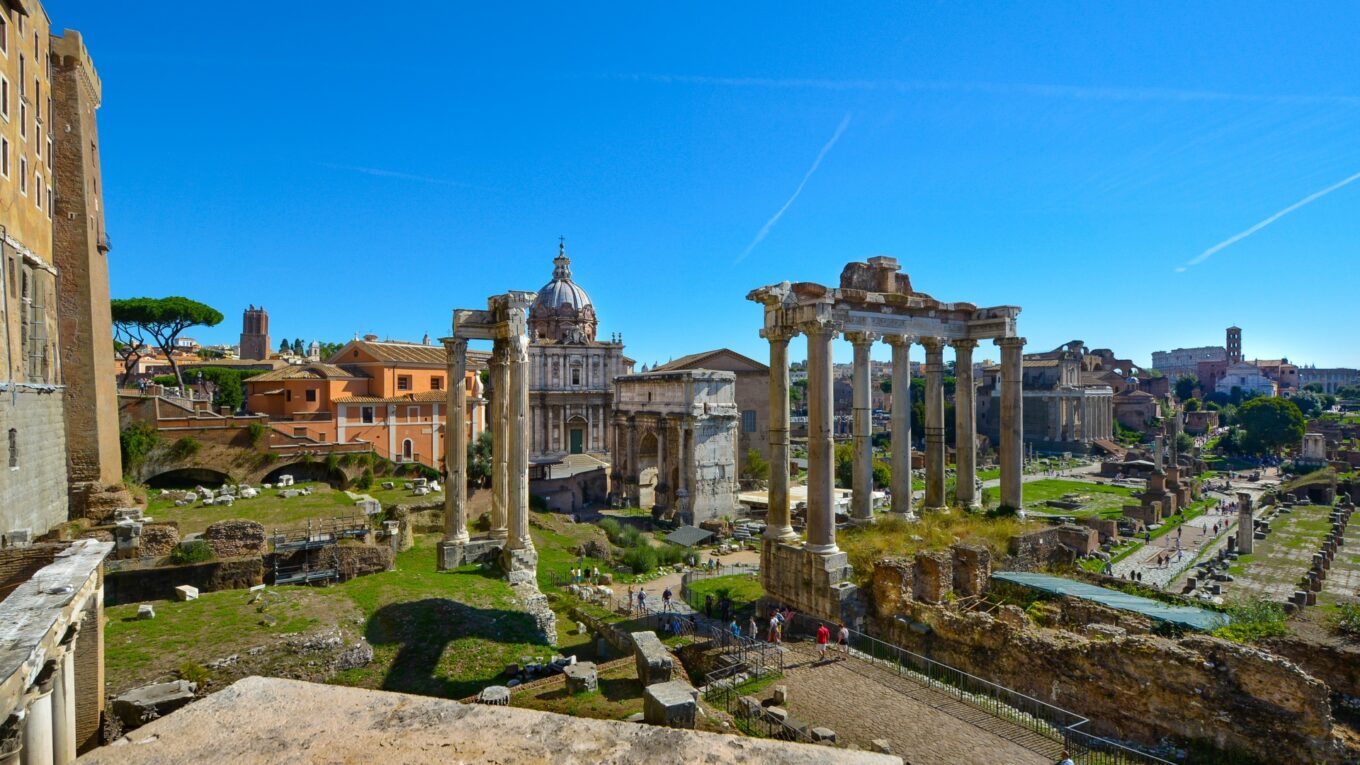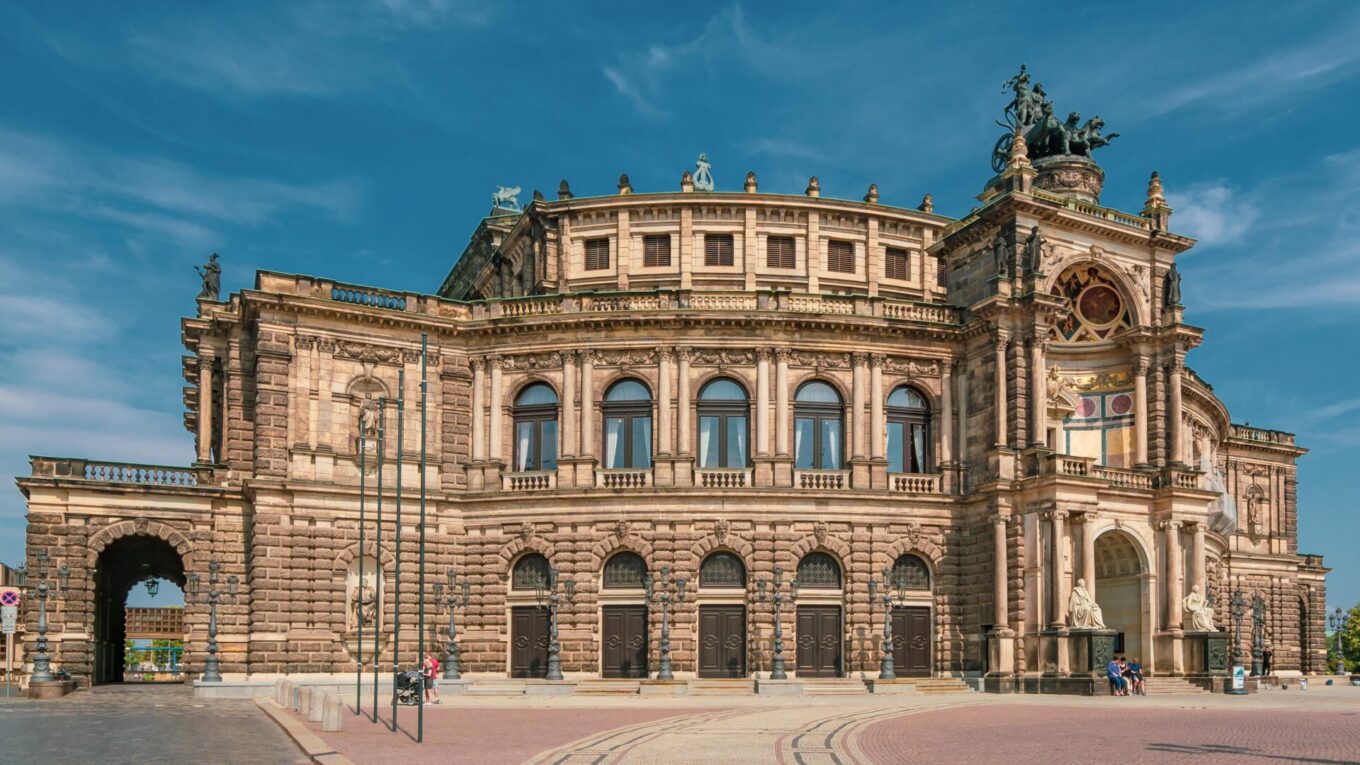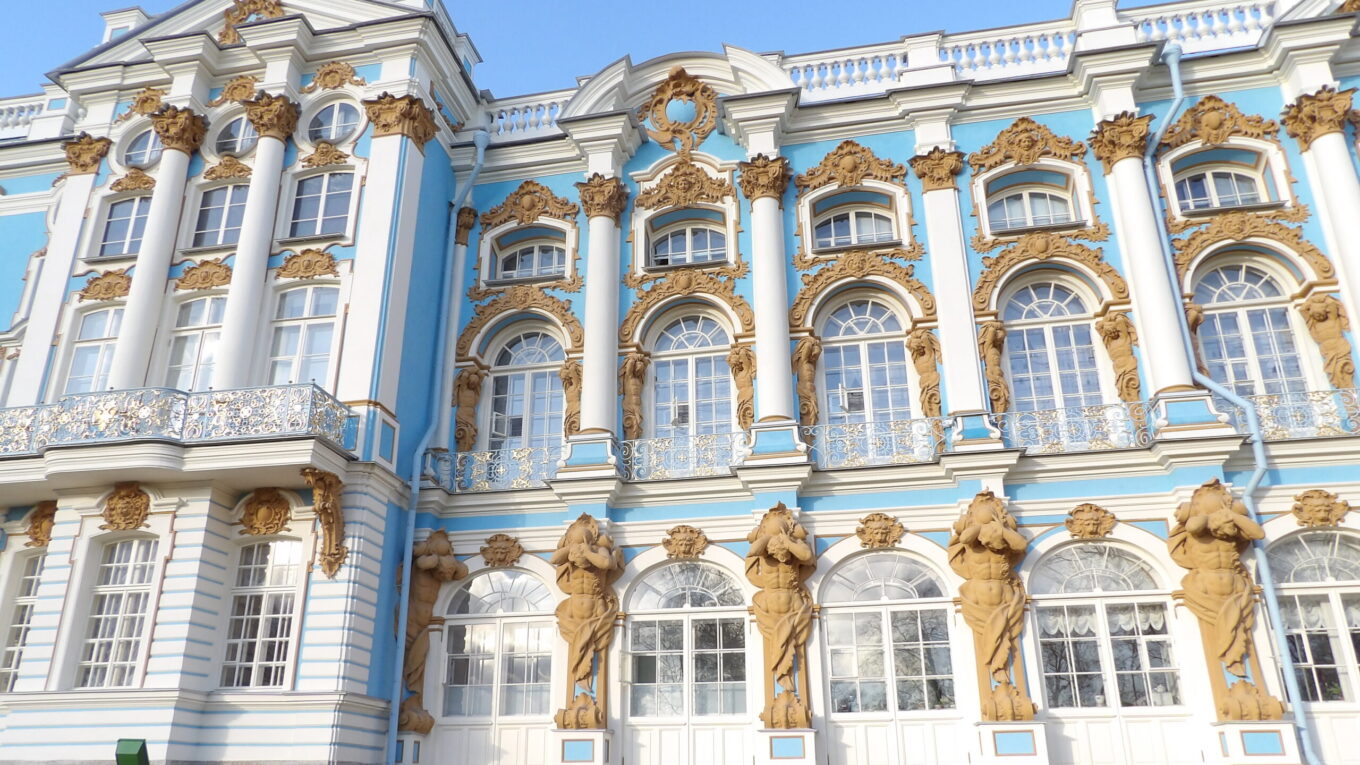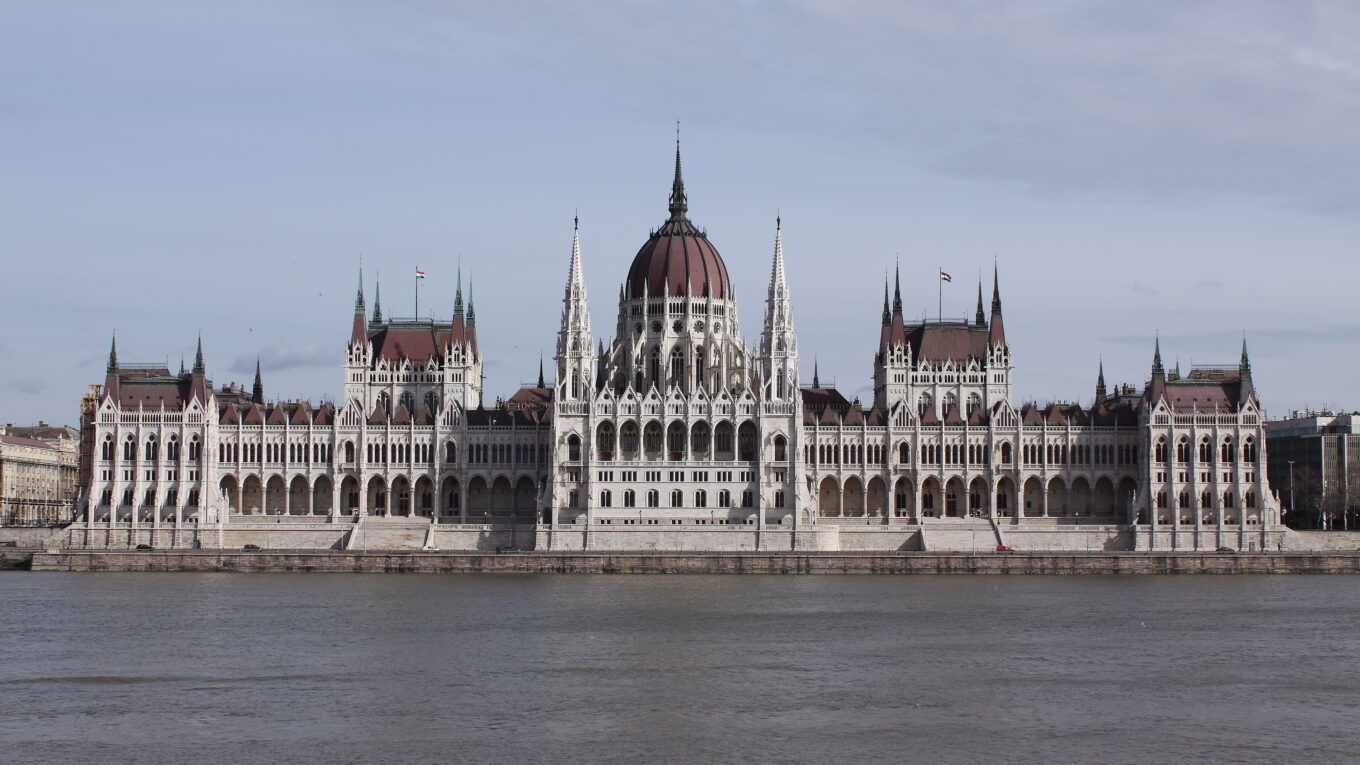Top 30 Ancient Roman Theaters
The Romans were one of the most advanced civilizations of the ancient world. In addition to being incredible engineers and conquerors, the Romans also had a passion for art, architecture, literature, and theater. Roman citizens would frequent theaters as a popular form of entertainment – a habit they picked up from the Ancient Greeks. To meet the demand for performances, most major cities within the Roman Empire were equipped with at least one theater. Today there are countless Roman Theaters throughout Europe and the Mediterranean, and the list below will highlight some of the greatest examples of these ancient monuments.
Who were the Romans, and why did they build so many Theaters?
At its peak, the Ancient Roman Empire spread from the British Isles in the northwest all the way to modern-day Egypt and Iraq in the southeast. The Romans built many structures such as amphitheaters, aqueducts, temples, and theaters, and all of these monuments played a different role in maintaining peace and prosperity within the empire. In the ancient world, plays and live performances were some of the only forms of entertainment, and it was common for Roman citizens to watch plays on a regular basis. To meet this demand, the Roman Empire built massive theaters, many of which were capable of holding 10,000 spectators or more at one time. Roman fondness for plays explains why nearly every city in the empire contained its own theater.
Parts of a Roman Theater
A section cut through a typical Roman Theater. Some of the key components are labeled such as the:
- Pulpitum – The main stage for the theater.
- Cavea – Rows of elevated seating that radiate out from the main stage.
- Orchestra – Space in between the stage and the seats.
- Scaenae Frons – The backdrop behind the stage.
The Top 30 Ancient Roman Theaters
Below is a list of some of the greatest Ancient Roman Theaters, highlighting many of the characteristics that make these structures so unique.
1. Roman Theater of Mérida (Spain)
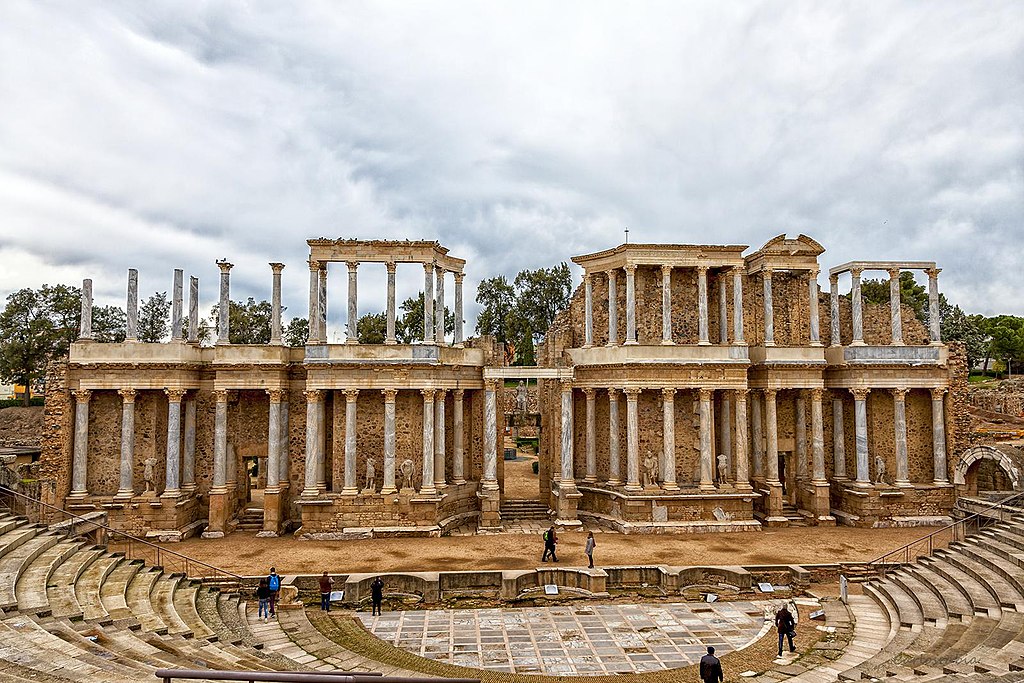
Mérida is a city in Spain’s Extremadura region, and in Roman times, it was known as Augusta Emerita. Mérida contains many incredible works of ancient architecture, including a Roman theater and an amphitheater. The theater is incredibly well preserved, and it contains an elaborate Scaenae Frons containing multiple Corinthian Columns and marble statues. The Theater of Mérida was originally constructed in 15 BCE, and it was expanded several times during the following centuries. Today, the theater is part of a UNESCO World Heritage Site known as the Archaeological Ensemble of Mérida.
2. Roman Theater of Orange (France)
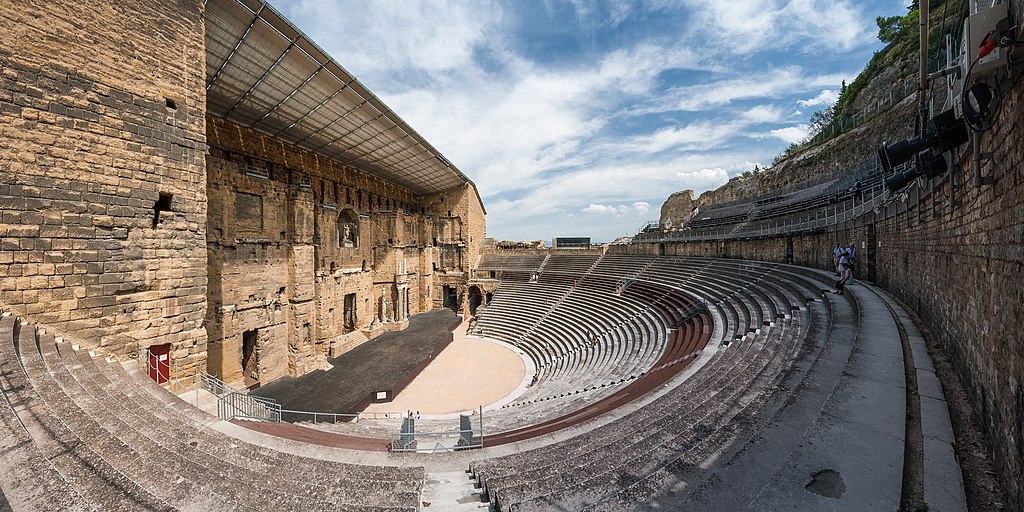
The Roman Theater of Orange is one of the best-preserved ancient monuments in all of France. Orange is a town in the French Region of Provence. Provence contains several cities with Roman Architecture, including Nîmes, Arles, and Avignon. Although a small town by Roman standards, Orange contains an impressive Triumphal Arch in addition to the theater. Construction began on the theater in the 1st century CE, and the seats and the Scaenae Frons remain remarkably well-preserved. Today, the Roman Theater of Orange still hosts occasional live performances, and it’s listed as a UNESCO World Heritage Site.
3. Roman Theater of Amman (Jordan)

The Roman Theater of Amman is one of the most infamous landmarks in the capital city of Jordan. The theater contains over 6,000 seats and it was built in the 2nd century CE during the reign of Antoninus Pius. He was the successor of Hadrian and was one of several emperors of the Nerva–Antonine Dynasty. Roman Theaters were either built freestanding or were built within an existing hillside. Here at Amman Theater, the Romans utilized an existing hill as the theater’s foundation. This was a clever way to save on materials and allowed the theater to be built cheaply and easily.
4. Roman Theater of Leptis Magna (Libya)

Leptis Magna was originally a city within the Carthaginian Empire until it was absorbed into the Roman Republic after the conclusion of the Punic Wars. The city sits on the coast of modern-day Libya, and it contains several impressive works of architecture, including a Roman Theater, Amphitheater, and a Triumphal Arch. The theater was built facing the sea, and the stage had a low backdrop so that people in the stands could still see the ocean beyond. The city of Leptis Magna was heavily expanded by the Roman Emperor Septimius Severus, who ruled from 193 to 211 CE.
5. Roman Theater of Sabratha (Libya)
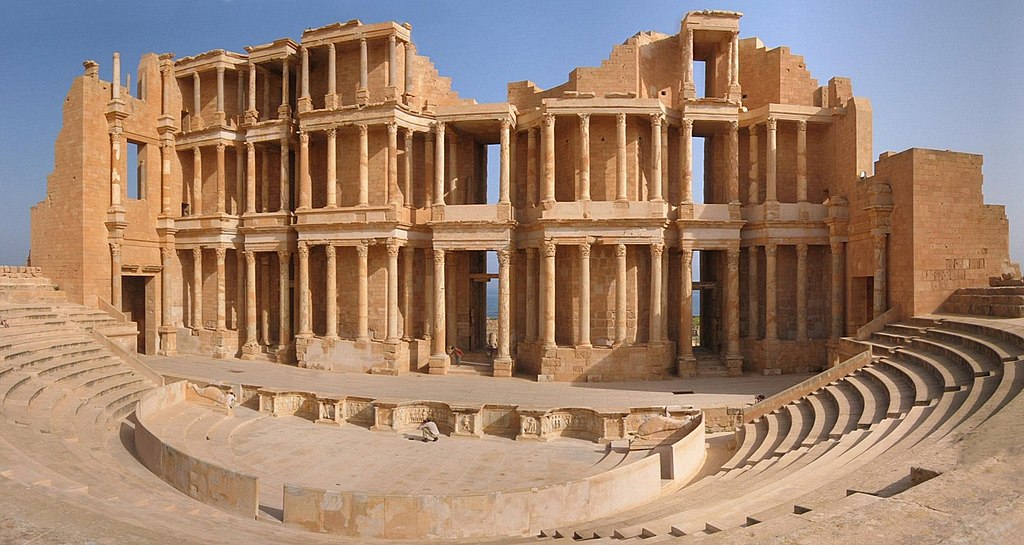
Located just 124 miles (200 km) from Leptis Magna, Sabratha is another Ancient Roman city in modern-day Libya. The Roman Theater of Sabratha is one of the best-preserved monuments from the now-ruined city. The theater contains one of the most elaborate stage backdrops or Scaenae Frons on this list. Here, the backdrop has three tiers of columns, and like the theater in Leptis Magna, the seats also face outward toward the Meditteranean Sea. Thanks to its several important ancient monuments, Sabratha was listed as a UNESCO World Heritage Site in the 1980s.
6. Roman Theater of Ephesus (Turkey)

Ephesus is a city in modern-day Turkey that was founded by the Ancient Greeks. It contains several incredible ancient monuments such as the Library of Celsus. Although the Theater of Ephesus was established by the Greeks, it was maintained and expanded during the lengthy period of Roman control. The Theater is one of the largest ever built in the ancient world, and it contains enough seating for 24,000 spectators. Originally the theater was located right next to the adjacent harbor of Ephesus; however, the coastline in this region of Turkey has shifted since ancient times, and the ocean now lies 2 miles (3 km) away.
7. Roman Theater of Hierapolis (Turkey)
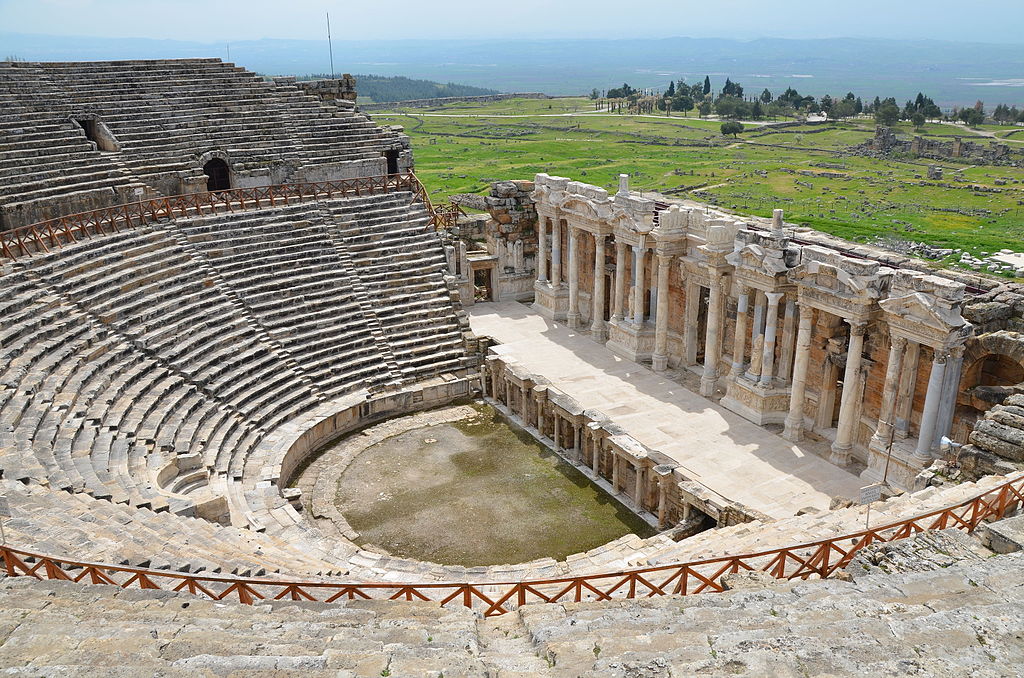
Hierapolis is another Ancient Greek City located in modern-day Turkey. Hierapolis came under the control of the Roman Republic in 133 BCE, along with the surrounding region of western Anatolia. Over the next 200 years, the city would see two devastating earthquakes, after which most structures had to be completely rebuilt. In addition to the theater, the Romans would build a new Forum, several Temples, and a Triumphal Arch. The theater was constructed during the reign of Emperor Hadrian, who ruled from 117-138 CE. It is over 330 feet (91 m) wide and had a capacity of 15,000.
8. Roman Theater of Bosra (Syria)

The Roman Theater of Bosra was completed in the 2nd century CE, and it’s one of the most impressive monuments in the former Roman city of Nova Trajana Bostra. The theater is constructed out of a dark Basalt rock that is found in the surrounding region of modern-day Syria. The backdrop of the theater contains several columns made from a much lighter stone, which contrasts the surrounding dark Basalt. The Bosra Theater could once hold up to 17,000 spectators, making it one of the largest Roman Theaters featured on this list.
9. Roman Theater of Plovdiv (Bulgaria)

Plovdiv, a city known as Philippopolis in ancient times, is one of the largest cities in Bulgaria, and it contains some of the finest works of Roman Architecture found anywhere in the Balkans. The Roman Theater of Plovdiv was constructed in the 1st century CE, and it has enough room for 5,000 spectators. It features a well-preserved backdrop made from white marble, and the theater is positioned with a commanding view over the rest of the city. In the image above you can see a wooden stage that was installed in modern times, and now the theater is used frequently for plays, concerts, and other performances.
10. Roman Theater of Aspendos (Turkey)
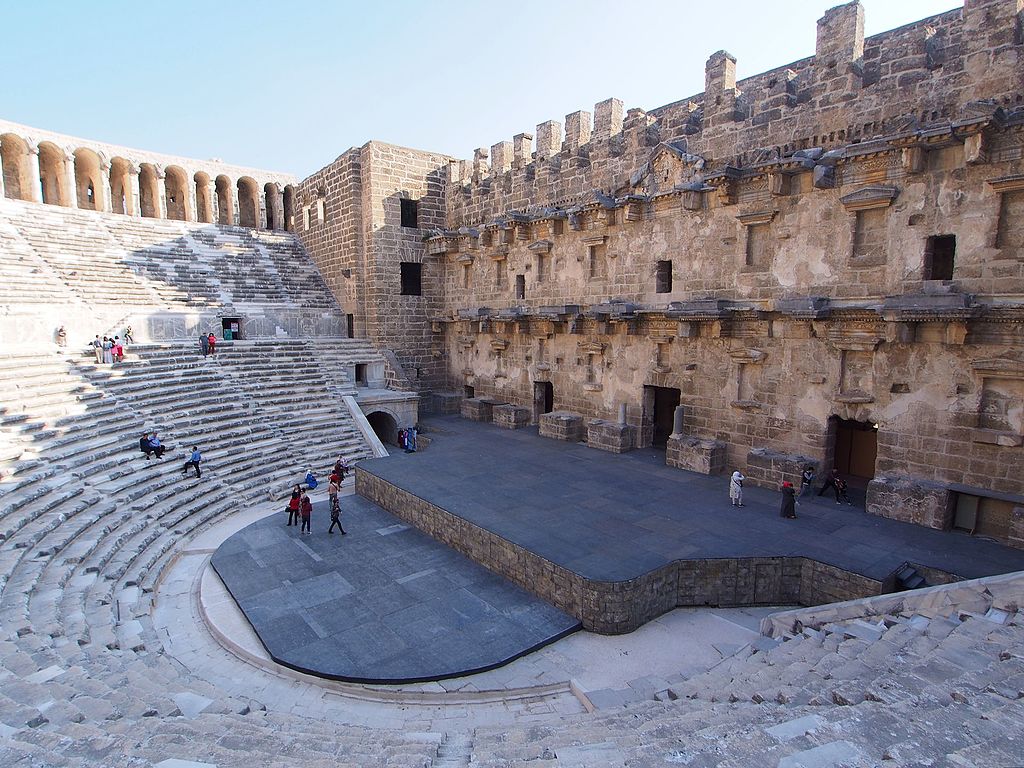
Aspendos is another ancient city that is located on the southern Mediterranean coastline of Turkey. Aspendos contains many incredible works of Roman Architecture, including a Basilica, an Aqueduct, and a Theater. The theater itself was originally built by the Ancient Greeks, with many expansions and modifications occurring during Roman times. The theater once contained an elaborate awning structure that created shade for the spectators. It was a similar design to the massive awnings that once existed in the Colosseum in Rome. Today, the Theater of Aspendos is still used for performances and it’s a popular attraction in southern Turkey.
11. Roman Theater of Jerash (Jordan)
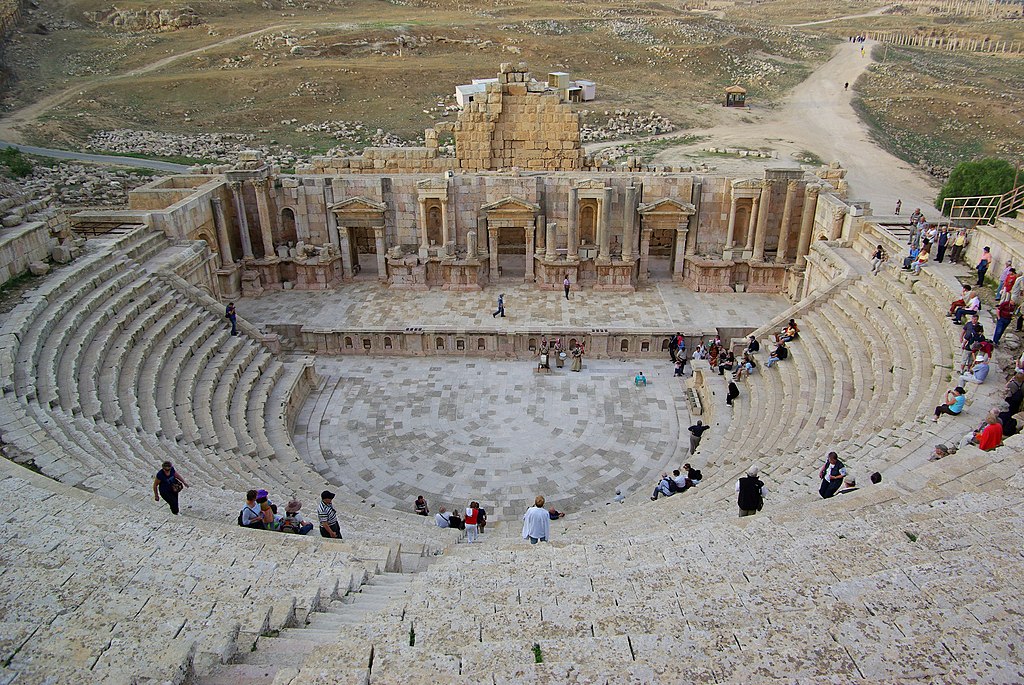
Jerash is a city located just 30 miles (48 km) north of Amman, the capital of Jordan. Originally known as Gerasa, Jerash contains many examples of Roman architecture, including the Triumphal Arch of Hadrian and a large oval-shaped Forum. Like many of the largest Roman cities, Jerash contained two different theaters in order to meet the demand for live performances. The image above shows the South Theater, which contains an elaborate Scaenae Frons, or backdrop, in addition to several rows of seats.
12. Roman Theater of Dougga (Tunisia)
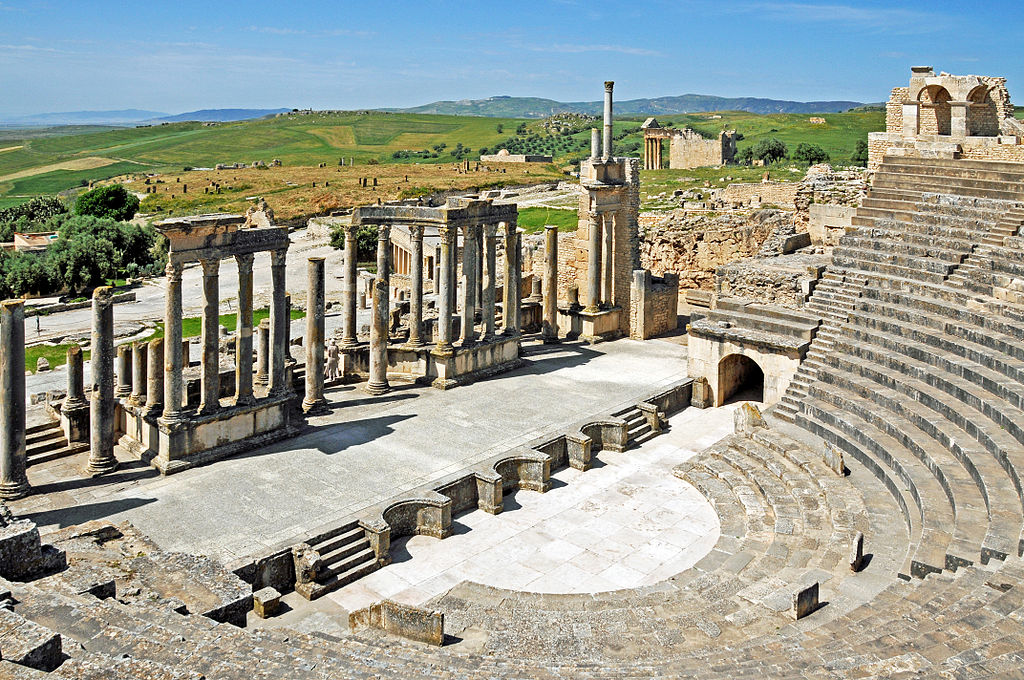
Dougga is a city located within the interior of the Roman Province of North Africa, in what is now Tunisia. The entire city of Dougga is listed as a UNESCO World Heritage Site, mostly for its architectural significance. The Roman Theater of Dougga was constructed in the late 2nd century CE, during the reign of Emperor Marcus Aurelius. Marcus Aurelius was known as one of Rome’s greatest emperors. He was an intellectual, a philosopher, and a very capable ruler. He is commemorated by an intricately carved Victory Column that still stands within Rome.
13. Odeon of Herodes Atticus (Athens, Greece)
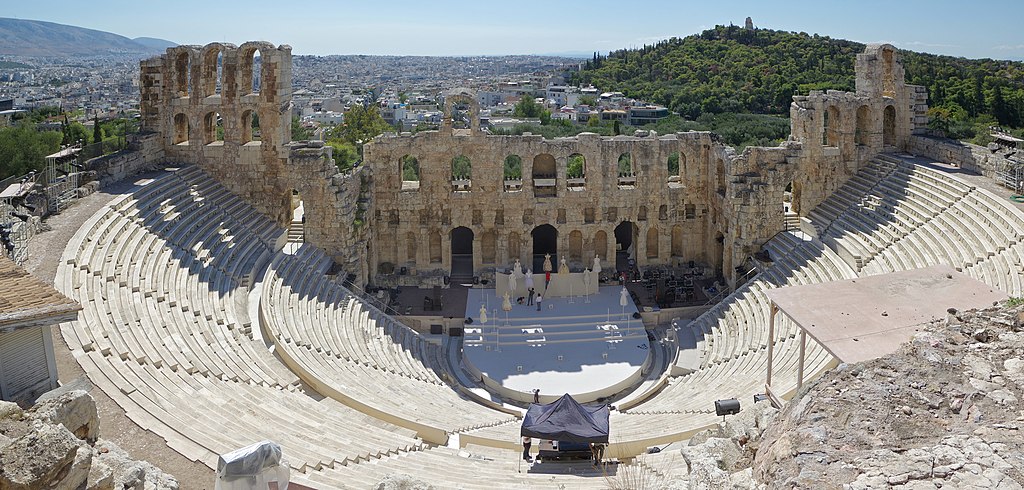
An Odeon was another building form that was commonly built by the Ancient Romans. The main difference between an Odeon and a theater is that Odeons were purposefully built for music rather than plays. Traditionally, Odeons are smaller than theaters, but this is likely because there was more demand for plays and therefore these structures were made larger. The Odeon of Herodes Atticus was originally built by the Ancient Athenians, a Greek City-State that was one of the most powerful in the entire Greek World. After Greece was conquered by the Romans, the Odeon was updated and expanded into the form that we see today.
14. Roman Theater of Bodrum (Turkey)
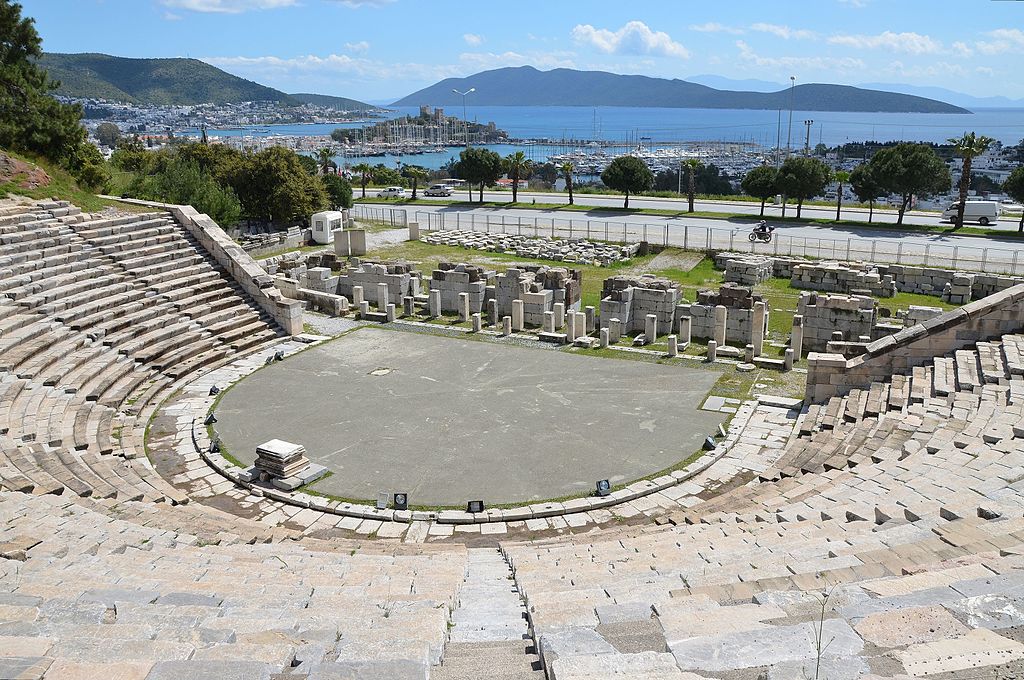
Bodrum is a city on the southern coast of Turkey, located where the Mediterranean Sea meets the Aegean Sea. In ancient times, Bodrum was known as Halicarnassus, and the theater originally dates to the Greek period. It was expanded and enlarged to its current 10,000-seat capacity in the 2nd century CE during the Roman era. The theater of Halicarnassus was built in an imposing location, overlooking the ocean and the mountains of Turkey’s rugged coastline. In the image above you can see the Castle of Bodrum next to the city’s harbor. It’s one of the finest Castles of the Crusader Era, and it was built by the Knights Hospitaler during the Middle Ages.
15. Roman Theater of Arles (France)
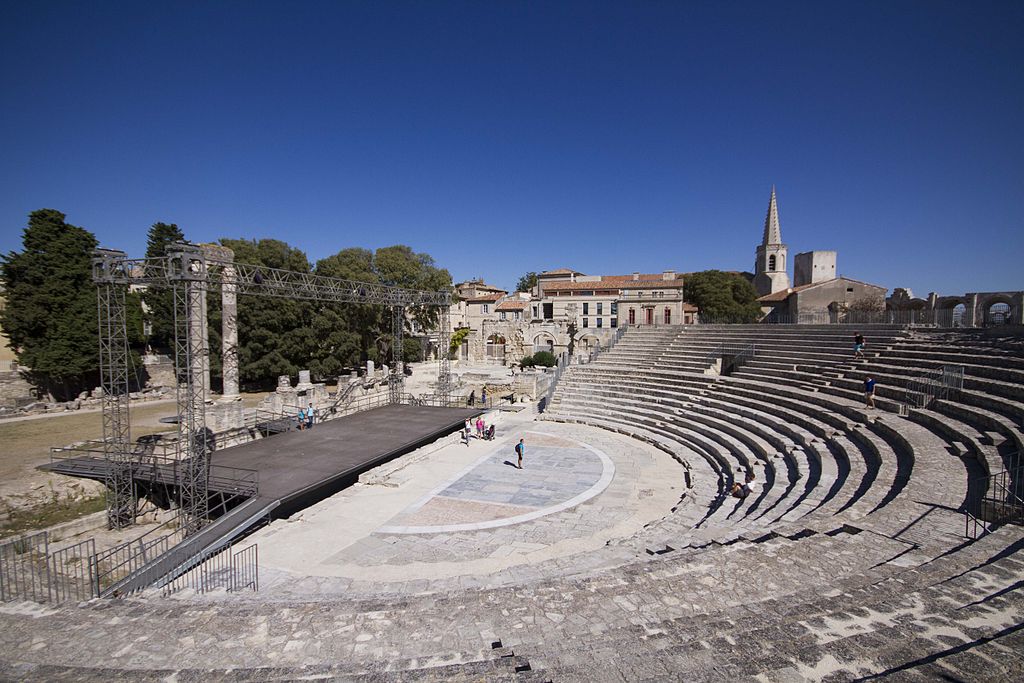
Arles is a city in France’s Provence region, and it contains a large theater in addition to an impressive Ancient Roman Amphitheater. Construction began on the theater in the 1st century CE, during the rule of Emperor Augustus. The theater could hold up to 8,000 spectators, and it once featured a large backdrop that was complete with a row of marble columns. However, like a lot of other ancient Roman buildings, most of the stones from this portion of the theater were repurposed and put into other structures. Thankfully, some of the backdrop and most of the seating remained, and you can still get a sense of how impressive the Ancient Theater of Arles must have been 2,000 years ago.
16. Roman Theater of Lyon (France)

Lyon is a city in France located where the Rhône and Saône Rivers meet. Today, Lyon is the third-largest city in France and is home to many incredible works of Gothic and Renaissance Architecture. The city was once a vital center within Ancient Roman Gaul, and it’s home to several Roman-era structures such as an Amphitheater, an Odeon, and a Theater. In the image above you can see what’s left of the Roman Theater, which at one point could hold 10,000 spectators. Much of the original structure was demolished, with the materials used in other buildings throughout Lyon. Today the Roman Theater of Lyon is protected as a UNESCO World Heritage Site along with the rest of Lyon’s historic center.
17. Roman Theater of Beit She’an (Israel)

One of two structures on this list located in modern-day Israel, the Roman Theater of Beit She’an was constructed during the Pax Romana, a nearly 200-year period of peace within the Roman Empire that lasted from 27 BCE – 180 CE. Like many other cities at this point in time, Beit She’an was retrofitted with all of the main staples you find in most Roman towns, such as a Chariot Racing Track or Hippodrome, several bathhouses, and a large theater. The Theater is only about 40% preserved, and most of the upper portions of the seating area and the majority of the backdrop are gone.
18. Roman Theater of Caesarea Maritima (Israel)

Caesarea Maritima was another important city in the Roman Province of Judea, now part of modern-day Israel. Caesarea Maritima was located along the waters of the eastern Meditteranean Sea, and it’s home to the remnants of an Aqueduct and a Roman Forum. Just like some of the other theaters located throughout the Roman Empire, the Theater of Caesarea Maritima was located facing the ocean. Today, only the foundation of the stage backdrop or, Scaenae Frons, remains, so anyone sitting in the stands gets an unencumbered view of the sea beyond.
19. Roman Theater of Djémila (Algeria)

Djémila is a city located in a rugged mountainous region of northern Algeria. In ancient times the city was known as Cuicul. It was built throughout the 1st century CE, and it was originally established as a colony for retired Roman soldiers – a practice that was common in the Roman Empire. Soldiers were often given land to settle as compensation for their efforts in battle, and many cities throughout Europe and the Mediterranean were established this way. In addition to the Roman Theater, Djémila is also filled with other sites such as a Forum, several Temples, and two main Roman Roads.
20. Roman Theater of Salamis (Cyprus)

Cyprus was an important maritime holding of the Roman Empire. Cyprus is rich in natural minerals including copper, and it was an important mining center for millennia since its copper ore was used extensively to make bronze. Salamis is an ancient city in eastern Cyprus, not far from the modern city of Famagusta. The city has Greek origins, and the Theater of Salamis was originally constructed in the Greek Hellenistic Age. Like a lot of the other theaters on this list, it was expanded and maintained by the Roman Empire. In the image above you can see two distinct materials – the first 5 to 8 rows of seating are made from white marble, while the upper rows of seating were added later and are made with a much darker stone.
21. Roman Theater of Palmyra (Syria)
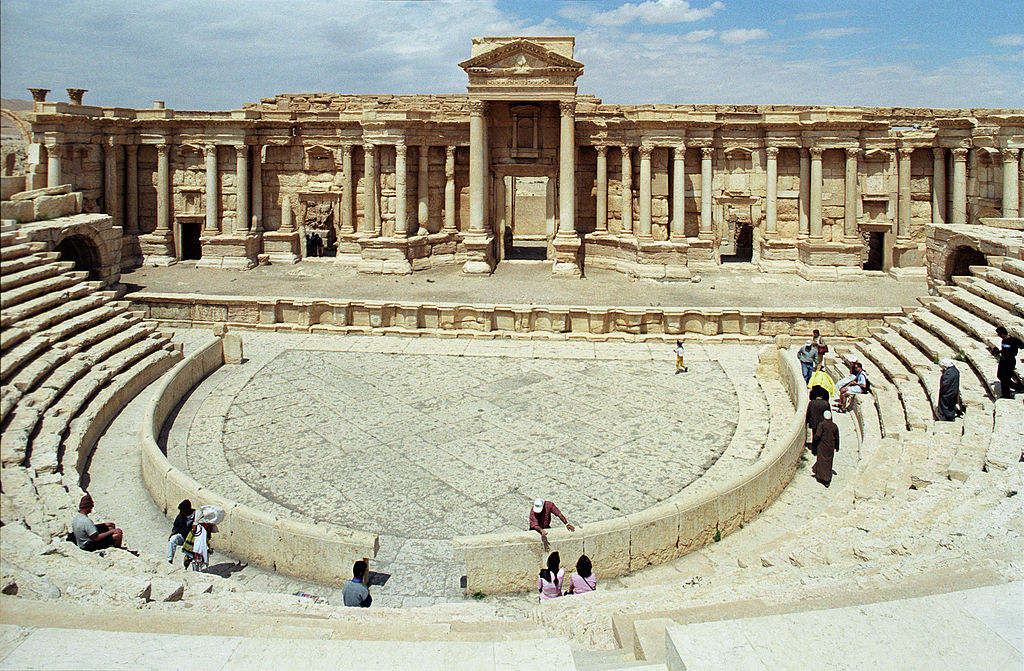
Palmyra was one of the leading cities in the Levant during the days of the Roman Empire. Palmyra is filled with an abundance of Roman Architecture, including temples, a Forum, and the Theater of Palmyra. The theater was constructed in the 2nd century CE, and it contains a very elaborate backstage area, decorated with pediments and Corinthian Columns. The image above shows the theater in the early 2010s before it was intentionally damaged by ISIS. In 2015, members of ISIS used explosives to damage many of the ancient monuments within Palmyra, including several temples, the theater, and a few one-of-a-kind statues.
22. Roman Theater of Vienne (France)

Vienne is a town in France, less than an hour’s drive south of Lyon. Vienne was an important city within the Roman Empire, and it was one of the commercial centers within the Roman Province of Gaul. The Roman Theater of Vienne was built into the side of a hill with the seats facing the town center and the Rhône River. In the image above you can see a modern-day stage that was built within the theater, which today hosts live events including an annual Jazz Festival. Like a lot of other towns in the region, Vienne contains a few major Roman Sites in addition to an impressive cathedral built in the French Gothic Style.
23. Roman Theater of Guelma (Algeria)

Guelma is a city in northeast Algeria, and in ancient times it was known as Calama. Calama was founded as a trading colony by the Phonecians, and it grew to be an important grain supplier for the Roman Empire by the 2nd century CE. The theater was completed in the early years of the 3rd century, and it is the most significant work of Roman Architecture in the entire city. The Scaenae Frons, which serves as the backdrop for the stage, is particularly unique. It contains four massive Corinthian Columns that flank a large doorway that leads to the backstage area. You can imagine the doorway and the columns being used as part of the performances that were once held within the theater.
24. Roman Theater of Side (Turkey)
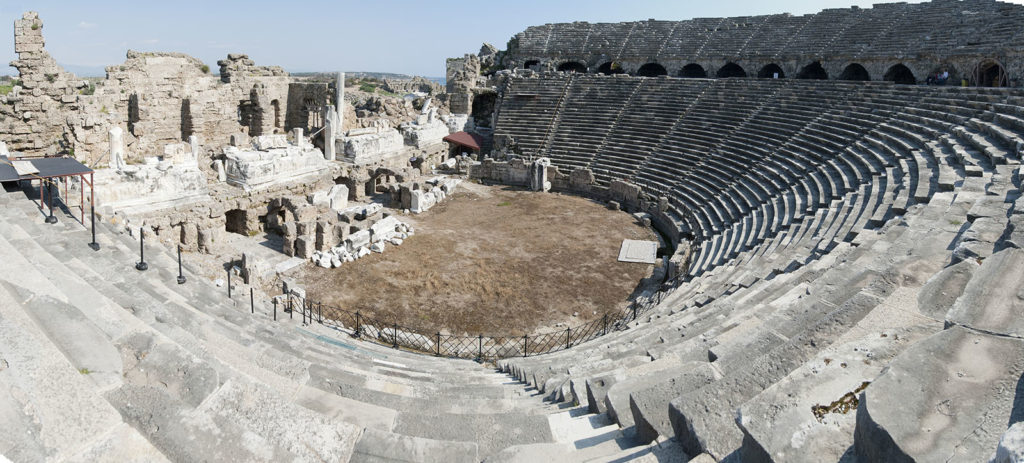
Like many ancient cities in modern-day Turkey, the city of Side was established by the Greeks as far back as the 7th century BCE. The city was taken over by Alexander the Great in 333 BCE, as he was making his way across Anatolia to take on the Persian Empire. The Theater of Side had a capacity of more than 15,000, making it one of the larger venues on this list. Many modifications were done to the Scaenae Frons during the Roman Period. Most of the seating for the theater remains intact, but a great deal of the stage and backdrop were used as a quarry, with the stones being taken for other buildings.
25. Roman Theater of Catania (Sicily, Italy)
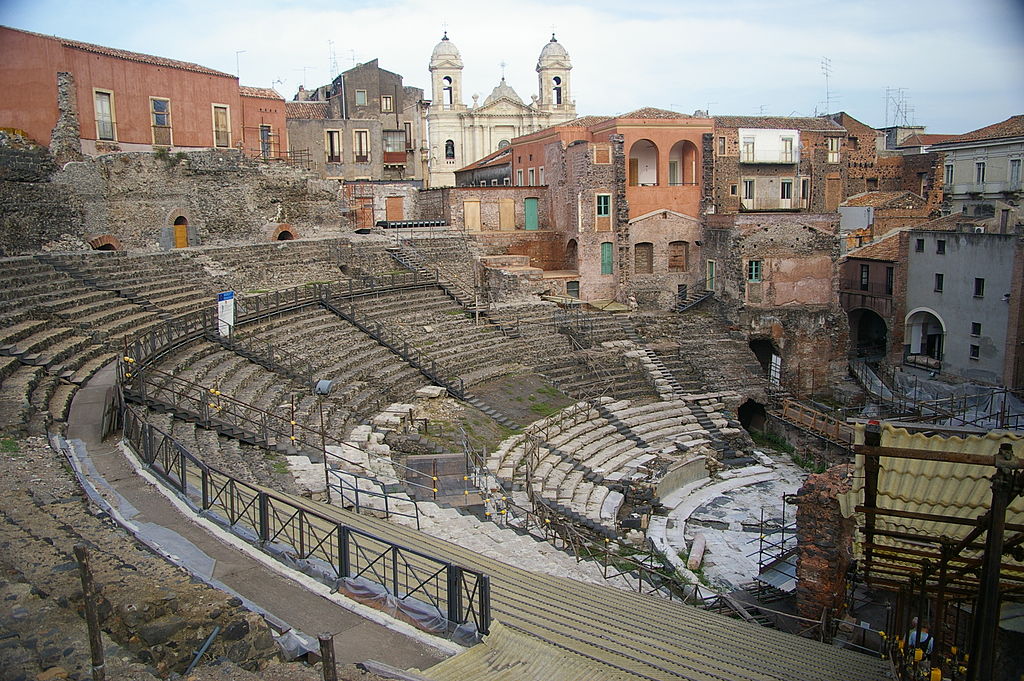
Catania, one of the two major cities on the Island of Sicily, was an important coastal city in the Roman Empire. It sits in the shadow of Mount Etna, an active volcano on the eastern side of the island. The Roman Theater of Catania is unique because it lies within the dense urban fabric of the surrounding city. In the image above, you can see how there are dozens of structures built right up against the theater, many of them using the stone of the theater as a makeshift foundation. Catania also contains a Roman Amphitheater, in addition to dozens of incredible works of Renaissance and Baroque Architecture.
26. Theater of Lecce (Italy)
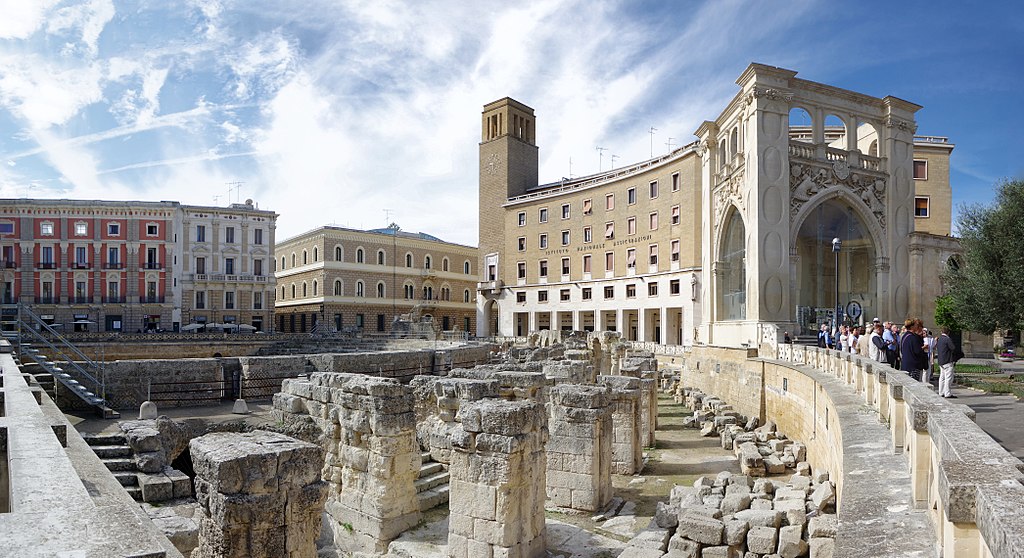
The Roman Theater of Lecce is just a shell of its former self, but it shows the strong link between the city and its Roman roots. Lecce is a city in the Italian Region of Apulia, which is located in the “heel” of the Italian Boot. Lecce is one of Italy’s most important cities for Baroque Architecture, along with Rome, Venice, and Naples. Because the city has been continuously inhabited since ancient times, the Roman Theater of Lecce and the city’s other ancient monuments were all used as sources for building materials. Many of Lecce’s more contemporary buildings are made from older stones from monuments that were abandoned after the fall of the Roman Empire.
27. Roman Odeon of Patras

The Roman Odeon of Patras is a significant work of Roman Architecture within the Greek city of Patras. Patras is located on the Peloponnese Peninsula, overlooking the waters of the Gulf of Corinth. The Odeon was originally made for live musical performances, but its structure is nearly identical to that of a Roman Theater. The Odeon shows the wide variety of materials that were utilized by the Ancient Romans. The vast majority of the structure is made from bricks which were cheaper and easier to work with than regular stone. The seating area and the floor of the orchestra section are made from white marble – a much more lavish and opulent material.
28. Roman Theater of Pompeii (Italy)
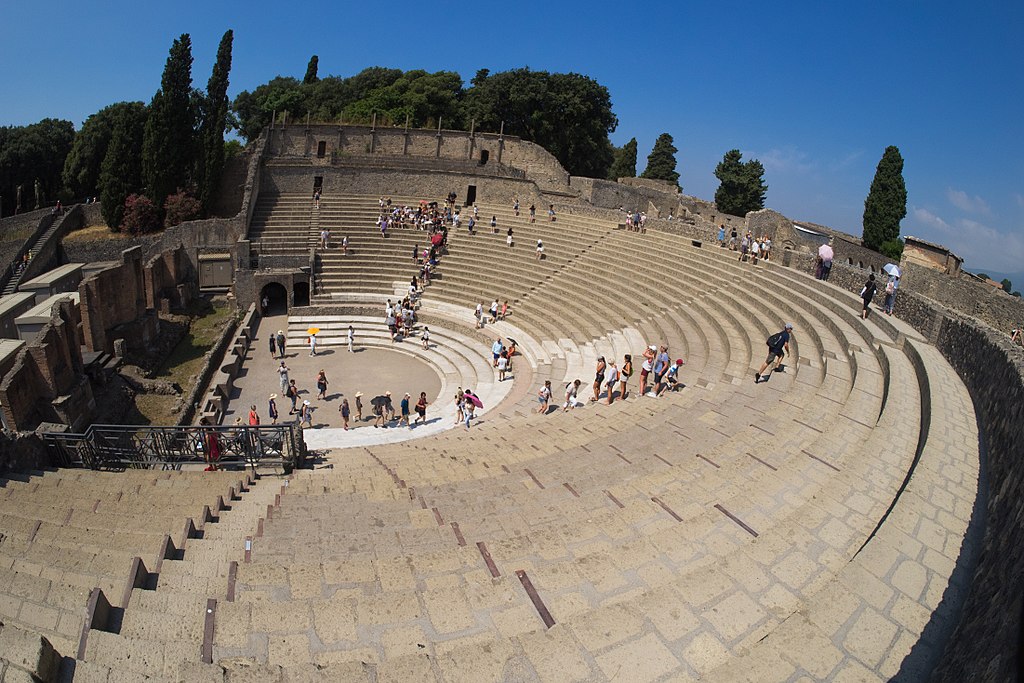
One of the oldest structures on this list, the Roman Theater of Pompeii was built starting in the 2nd century BCE. Pompeii actually contained a small Odeon and a larger theater. Both structures are located right next to one another, in an area known as the Theater District of Pompeii. Like so much of the rest of the city, the Theater of Pompeii is remarkably well-preserved. It was completely encapsulated by a thick layer of volcanic ash, after the eruption of Mt. Vesuvius in 79 CE. Archaeologists have since excavated most of the theater, but much of the historic site of Pompeii has yet to be excavated and many of the city’s secrets still lie beneath a 2,000-year-old layer of ash.
29. Roman Theater of Kourion (Cyprus)
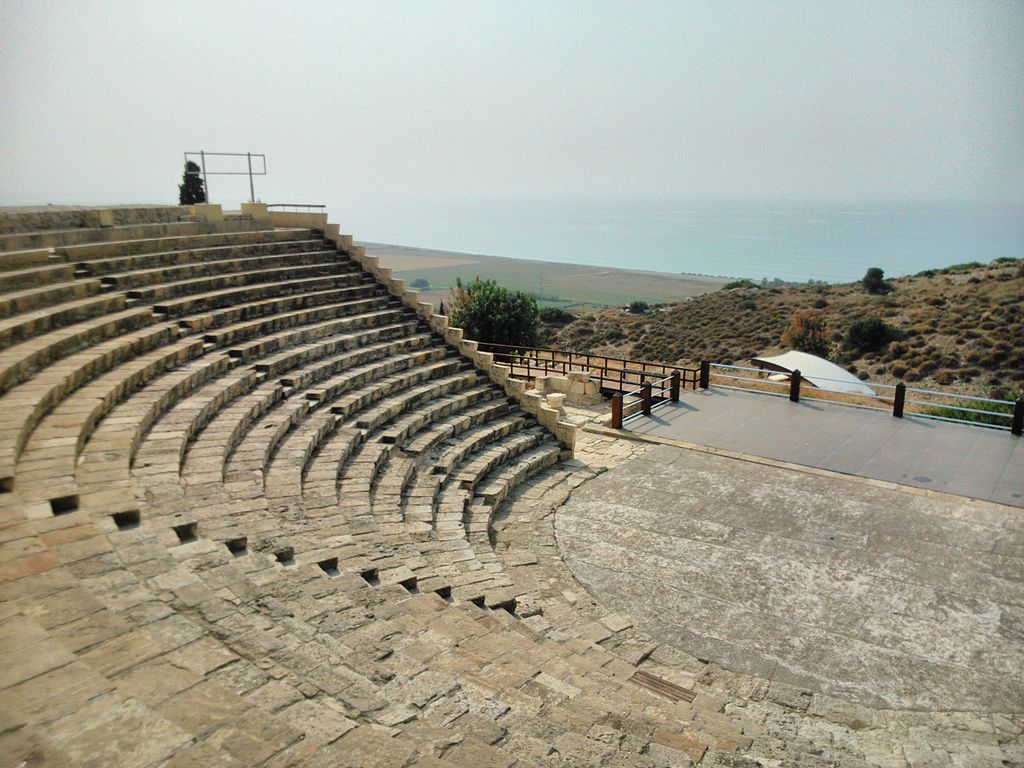
The second structure on this list from the Island of Cyprus is the Roman Theater of Kourion. Kourion is a city that sits on the southern edge of Cyprus, on a high bluff overlooking the ocean. The theater itself has a commanding position and all of the spectators get a great view of the sea in addition to the stage. Like many other Roman Theaters in the eastern Mediterranean, the Theater of Kourion is of Greco-Roman origin. It was established by the original Greek settlers of the city, and it was maintained and upgraded periodically during Roman times.
30. Roman Theater of Butrint (Albania)
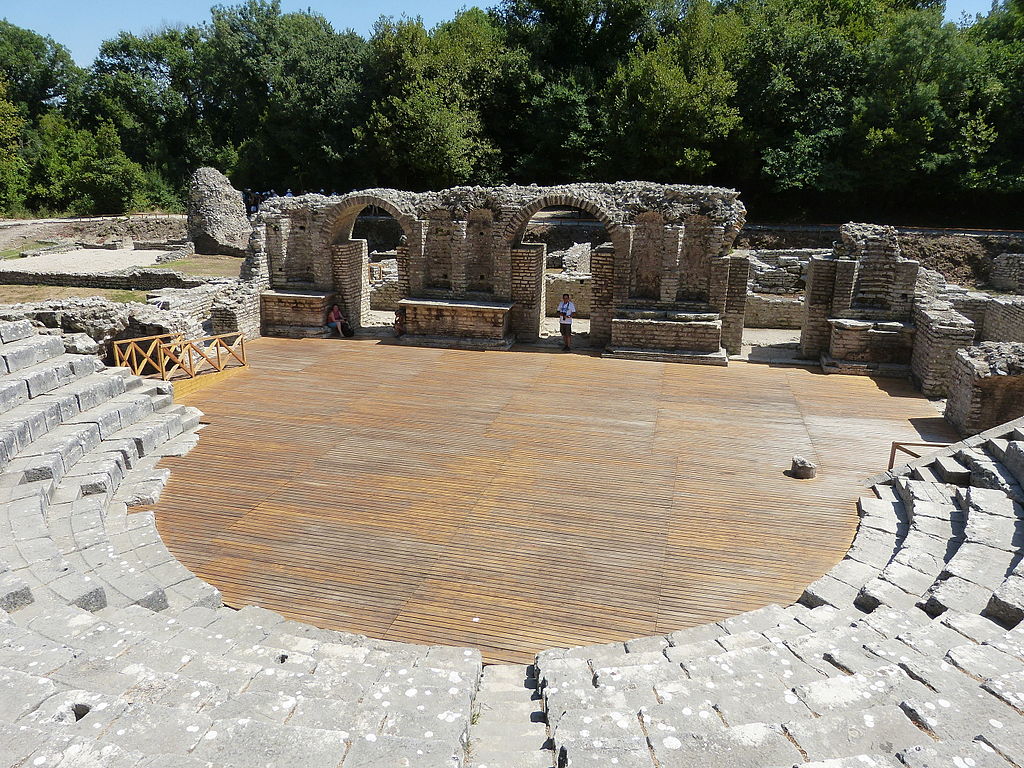
Located on the shores of the Adriatic Sea in modern-day Albania, the ancient city of Butrint contains several well-preserved examples of Roman Architecture. Butrint contains a theater, in addition to a Forum, some temples, and a Roman Bath. The theater is relatively small compared to others on this list, and much of the original stonework was repurposed in other buildings. Butrint was a notable city within the Republic of Venice, and it held out against several Ottoman Sieges during the Venetian-Ottoman Wars.
Other examples of Ancient Theaters
Throughout the world, there are many other examples of structures that greatly resemble Ancient Roman Theaters. In the image below, you can see the incredible Theater of Petra, in modern-day Jordan. Petra is a very unique city, and it’s filled with some of the world’s greatest examples of Rock-Cut Architecture. The city was founded by the Nabataeans, who were a client state of the Roman Empire. The theater could seat over 8,000 people, and unlike all of the theaters above it was completely carved out of a hillside, and all of the seats are monolithic and made from solid rock.

The Ancient Romans borrowed their love of plays and theater from the Greeks. The Greeks had been writing both comedic and tragic plays for centuries prior to the establishment of the Roman Republic. Many of the theaters on this list have Greek Origins, particularly the ones in the former Greek World – which was a vast area centered around the Aegean Sea. In the image below, you can see the Theater of Dionysus, one of several performance venues centered around the Acropolis in Athens. While most of the theater lies in ruin, during the Athenian Golden Age the Theater of Dionysus could hold nearly 17,000 spectators, and it was one of the most iconic monuments in all of Athens.
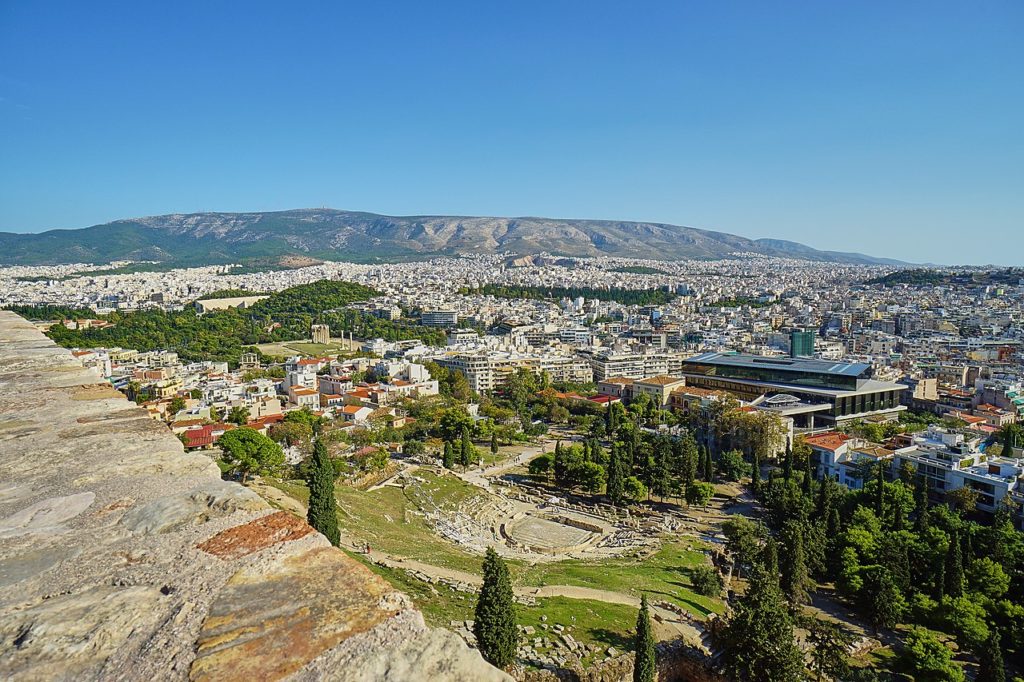
Influence of Roman Theaters
The influences of Roman Theaters can still be seen throughout the modern world. The actual structure of these theaters is timeless, and it has been repeatedly replicated throughout history. Virtually all performance venues of the modern age are cast from the same mold as the ancient theaters of the Greeks and Romans. Theaters were so important to the Roman people that virtually every city in the empire contained at least one, if not multiple. Many of these venues are still utilized for performances today, which shows the lasting impact that these structures have had on the modern world.

- About the Author
- Rob Carney, the founder and lead writer for Architecture of Cities has been studying the history of architecture for over 15 years.
- He is an avid traveler and photographer, and he is passionate about buildings and building history.
- Rob has a B.S. and a Master’s degree in Architecture and has worked as an architect and engineer in the Boston area for 10 years.
Like Architecture of Cities? Sign up for our mailing list to get updates on our latest articles and other information related to Architectural History.

